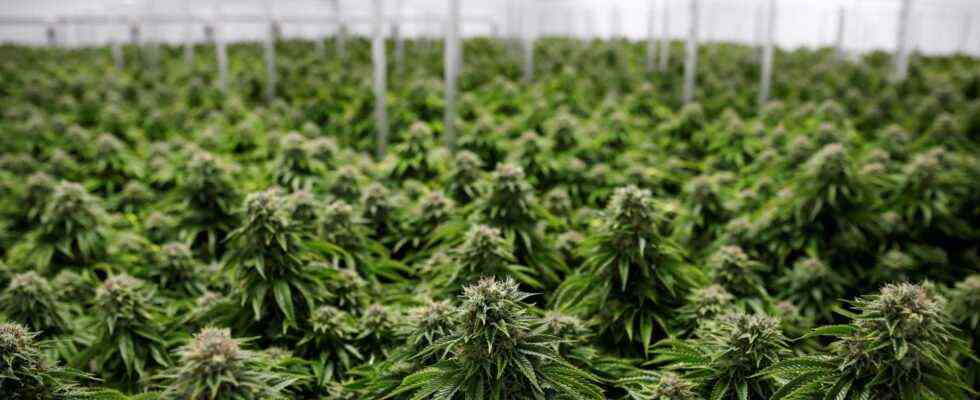Status: 10/24/2021 10:38 a.m.
Cannabis has been legal in Canada for three years. The once euphoric expectations have not been fulfilled. The country had to learn a lot first. Nevertheless, experts speak of a success.
When the first legal cannabis shops opened in Montreal on October 17, 2018, people were queuing around several blocks. It was an event with worldwide attention: the first large western industrialized country legalized the trade and use of hashish, marijuana and, subsequently, many other cannabis products. The stock exchanges also looked spellbound to Canada, as the economy was hoping for a multi-billion dollar business.
Today nobody stands in line at the “dispensaries”, the cannabis dispensaries in Canada. They are state-licensed or – as in Quebec – completely state-run. It took a long time for them to establish themselves somewhat. SQDC, which controls cannabis distribution in Canada’s second largest province, Quebec, sold around nine tons of cannabis products in the first year – in just 23 stores. In Canada’s largest state, Ontario, the first state-owned store only opened after eight months.
Three years of government cannabis business in Canada
Rupert Wiederwald / Christelle Richter, ARD New York, Mittagsmagazin, 10/22/2021
Insufficient infrastructure for production and demand
Far too weak infrastructure could not handle both the huge amounts of cannabis brought to market by new breeding farms and the needs of Canadians. The result: Large quantities of legal cannabis remained in the department stores, and many customers bought where they had always bought: from local dealers.
“We had to learn that there is a difference between legalization and the moment we were able to open the first stores,” says David Hammond of the University of Waterloo. The public health expert has accompanied the legalization from the start with a large-scale study. “In the beginning there were a lot of exaggerated expectations and a gold rush atmosphere in the industry,” said Hammond. “But we had a black market here that had been established for decades. And now – after three years – we are at the point where the majority of cannabis users perceive and use the legal market. Something like that takes time.”
In the meantime, according to Hammond’s surveys, state cannabis shops cover about half of the market. In Quebec, for example, SQDC sold 90 tons in its 78 shops last year.
Impatience with cannabis producers
For many, it’s all too slow. Impatience is particularly widespread among cannabis breeders: They saw big business, instead many have to fight. There are now 600 companies jostling into the market, which is nowhere near as big as many people thought.
Peter Schissler has been in the business from the start. His company Great White North began growing cannabis for medical purposes in Canada as early as 2013, and in 2019 the license came to grow cannabis for the “recreational market”, as Canadians call it. Above all, Schissler would like more opportunities to advertise his product. “We are not allowed to advise our customers or tell them which plant is better for them – that is an enormous obstacle for companies like us,” he says.
Schissler likes to guide his visitors through the futuristic-looking greenhouses of his company. The hemp plants grow on meter-high vertical columns that rotate. So they should be evenly supplied with light and moisture. Schissler is basically optimistic. “The market is still young,” he says. “I think in ten years many of the teething troubles will be over.” The government has already withdrawn some of the rules. Schissler points out that Canada’s authorities have now approved cannabis-infused foods, which initially seemed impossible.
In the greenhouses of Great White North, the hemp plants grow on meter-high vertical columns that rotate.
Image: Cristelle Richter, ARD Studio New York
Side by side of black market and legal products
The problem for Schissler and other breeders: In Canada, the black market and legal products still coexist. And on the black market, customers get more products than in state shops.
Even before legalization, Canada was the country with the most cannabis users in the world. A quarter of the population regularly consumes hashish, marijuana or cannabis-infused foods in their leisure time or for medical reasons – 60 percent have had contact with cannabis products.
Medical use of the drug has been permitted since 2001. Nevertheless, the step towards full legalization in 2018 was not without controversy. The aim of legalization was to get the vast majority of consumers out of illegality without completely losing control. This is one of the reasons why the authorities continue to tolerate certain black market structures, for example in the reservations of the indigenous population of Canada. The hope: the state-regulated product will prevail in the long term.
Number of consumers did not increase
A strategy that, according to the studies by David Hammond, can work. However, they need time. After all, says the health expert, one of the main goals has been achieved: The number of consumers has not increased, especially among minors: “We actually have a win-win situation,” said Hammond. “The state gradually controls more parts of the market and takes over the black market, thereby getting more tax revenue and at the same time providing effective protection for young people.”
According to Hammond’s studies, legalization has not resulted in minors using more or changing their attitudes towards cannabis. At the same time, fewer young people would be committing cannabis offenses. “Less pressure brought more control, which is one of the most important lessons,” says Hammond. “It is not really surprising that more and more states like Germany are considering legalization.”

